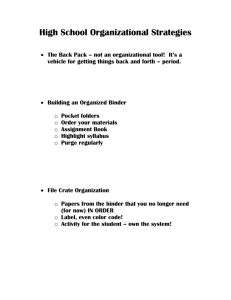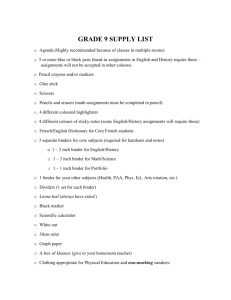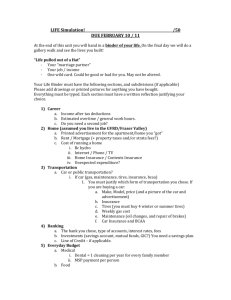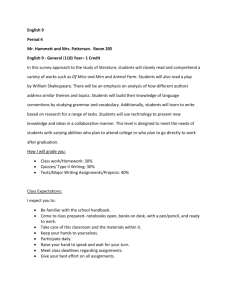LABORATORY AND ALT-EVALUATION OF HIGH
advertisement
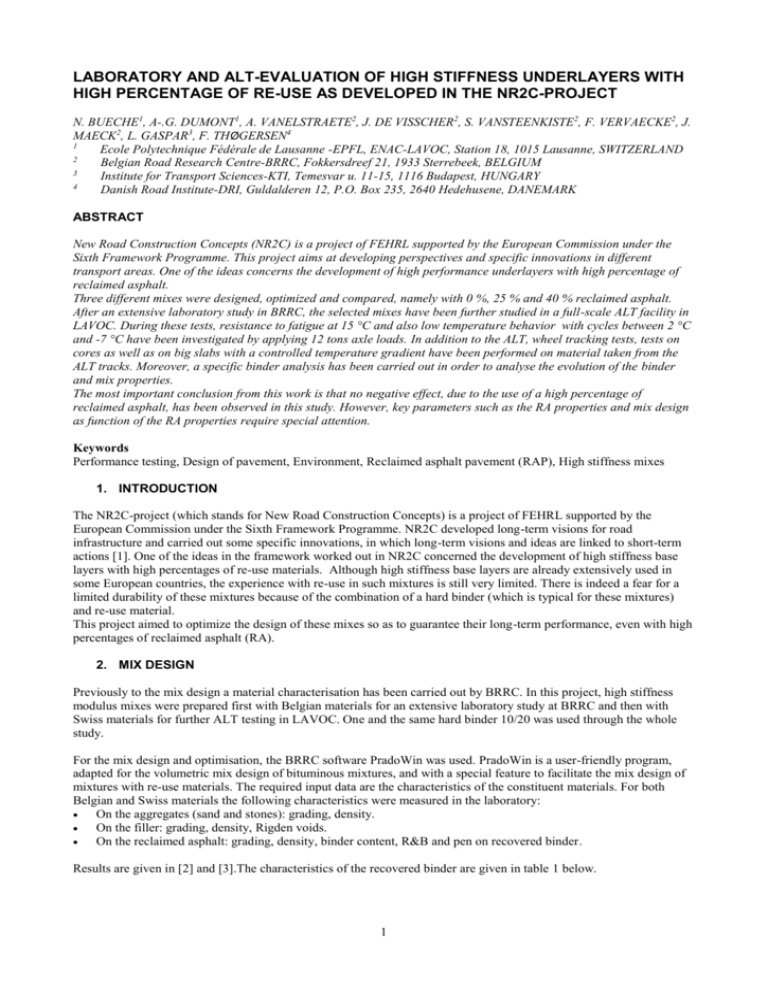
LABORATORY AND ALT-EVALUATION OF HIGH STIFFNESS UNDERLAYERS WITH HIGH PERCENTAGE OF RE-USE AS DEVELOPED IN THE NR2C-PROJECT N. BUECHE1, A-.G. DUMONT1, A. VANELSTRAETE2, J. DE VISSCHER2, S. VANSTEENKISTE2, F. VERVAECKE2, J. MAECK2, L. GASPAR3, F. THØGERSEN4 1 Ecole Polytechnique Fédérale de Lausanne -EPFL, ENAC-LAVOC, Station 18, 1015 Lausanne, SWITZERLAND 2 Belgian Road Research Centre-BRRC, Fokkersdreef 21, 1933 Sterrebeek, BELGIUM 3 Institute for Transport Sciences-KTI, Temesvar u. 11-15, 1116 Budapest, HUNGARY 4 Danish Road Institute-DRI, Guldalderen 12, P.O. Box 235, 2640 Hedehusene, DANEMARK ABSTRACT New Road Construction Concepts (NR2C) is a project of FEHRL supported by the European Commission under the Sixth Framework Programme. This project aims at developing perspectives and specific innovations in different transport areas. One of the ideas concerns the development of high performance underlayers with high percentage of reclaimed asphalt. Three different mixes were designed, optimized and compared, namely with 0 %, 25 % and 40 % reclaimed asphalt. After an extensive laboratory study in BRRC, the selected mixes have been further studied in a full-scale ALT facility in LAVOC. During these tests, resistance to fatigue at 15 °C and also low temperature behavior with cycles between 2 °C and -7 °C have been investigated by applying 12 tons axle loads. In addition to the ALT, wheel tracking tests, tests on cores as well as on big slabs with a controlled temperature gradient have been performed on material taken from the ALT tracks. Moreover, a specific binder analysis has been carried out in order to analyse the evolution of the binder and mix properties. The most important conclusion from this work is that no negative effect, due to the use of a high percentage of reclaimed asphalt, has been observed in this study. However, key parameters such as the RA properties and mix design as function of the RA properties require special attention. Keywords Performance testing, Design of pavement, Environment, Reclaimed asphalt pavement (RAP), High stiffness mixes 1. INTRODUCTION The NR2C-project (which stands for New Road Construction Concepts) is a project of FEHRL supported by the European Commission under the Sixth Framework Programme. NR2C developed long-term visions for road infrastructure and carried out some specific innovations, in which long-term visions and ideas are linked to short-term actions [1]. One of the ideas in the framework worked out in NR2C concerned the development of high stiffness base layers with high percentages of re-use materials. Although high stiffness base layers are already extensively used in some European countries, the experience with re-use in such mixtures is still very limited. There is indeed a fear for a limited durability of these mixtures because of the combination of a hard binder (which is typical for these mixtures) and re-use material. This project aimed to optimize the design of these mixes so as to guarantee their long-term performance, even with high percentages of reclaimed asphalt (RA). 2. MIX DESIGN Previously to the mix design a material characterisation has been carried out by BRRC. In this project, high stiffness modulus mixes were prepared first with Belgian materials for an extensive laboratory study at BRRC and then with Swiss materials for further ALT testing in LAVOC. One and the same hard binder 10/20 was used through the whole study. For the mix design and optimisation, the BRRC software PradoWin was used. PradoWin is a user-friendly program, adapted for the volumetric mix design of bituminous mixtures, and with a special feature to facilitate the mix design of mixtures with re-use materials. The required input data are the characteristics of the constituent materials. For both Belgian and Swiss materials the following characteristics were measured in the laboratory: On the aggregates (sand and stones): grading, density. On the filler: grading, density, Rigden voids. On the reclaimed asphalt: grading, density, binder content, R&B and pen on recovered binder. Results are given in [2] and [3].The characteristics of the recovered binder are given in table 1 below. 1 Type Pen [1/10mm] R&B [°C] % Belgian RA 17 67.3 5.5 Swiss RA 32 59.4 4.8 Table 1: Characteristics of the recovered binder of the reclaimed asphalt High stiffness mixtures for base layers can be achieved by using a high percentage of stones and a hard binder. Together with an increased binder content compared to a conventional asphalt composition suitable for base layers, this allows to design, despite of the high percentage of stones, relatively dense mixtures with a good coating of the aggregates and hence, a good performance in durability. Two basic mix designs were made: one mix design with Belgian materials, one mix design with the Swiss materials to be used in the ALT study. Different variants (with different percentages of RA) were designed, based on approximately the same grading curve: Variant 1: Design without RA (reference). Variant 2: Design with 25 % RA. Variant 3: Design with 40 % RA. The analytical mix design was combined with subsequent gyratory compaction tests according to EN12697-31 to verify the compactability and the air void content. Depending on the results of the gyratory tests, the analytical mix design was adapted. Figure 1 compares the grading curves of the mixes with Belgian and Swiss materials. The different curves are very close. Only the curves for the mixes with no RA show a difference (by 6 % at most) that is due to the difference in grading of the two fillers. 100 Belgian materials-0% RA 90 % passing Swiss materials-0% RA Belgian materials-25% RA 80 Swiss materials-25% RA 70 Belgian materials-40% RA 60 Swiss materials-40% RA 50 40 30 20 10 0.01 0.1 1 sieve (mm) 10 0 100 Figure 1: Grading of the different mix variants It is important to notice that the percentage of RA given stands for the percentage of old binder (from RA) on the total binder content. As the Swiss RA contains less binder (see table 1), the Swiss mixes with 25 % RA and 40 % RA contain relatively more re-use aggregates (respectively 29.5% and 47.4 %). 3. LABORATORY PERFORMANCE OF THE MIXES An extensive laboratory study was performed on all mixtures to check the laboratory performances: Stiffness modulus was determined according to EN12697-26 annex A (two-point bending test on trapezoidal samples) for temperatures between -20 °C and 30 °C and for frequencies between 1 and 30 Hz. Resistance to fatigue of the different mixes was determined according to the BRRC-method [4] (two point bending test on trapezoidal samples) at 15 °C and 10 Hz. This test method is close to EN12697-24 annex A, but is stress controlled and performed on larger samples. Resistance to permanent deformation is determined according to EN12697-22 (large device in air) at a temperature of 50 °C. 2 Water sensitivity is evaluated by the indirect tensile strength ratio (indirect tensile strength according to EN1269723 before and after conditioning in water according to EN12697-12). The results are given in table 2. We note that for the Swiss mixtures with RA, some of the tests were performed with a lower binder content (5.7 and 5.6 % for 25 % and 40 % of RA respectively, instead of 5.8 %). The reason for this is that in an asphalt plant, the variations on binder content of RA are usually larger than in the laboratory. With a high percentage of re-use, the impact of this parameter on the total binder content is important. A way to deal with this uncertainty in the phase of mechanical performance testing is to make the tests with the most unfavorable estimation of the binder content. For the mix with 40 % of RA, a variation of 0.5 % on the binder content of the RA would lead to a variation of 0.2 % on the total binder content. By doing some tests with a total binder content of 5.6 % instead of 5.8 %, the laboratory tests will be on the safe side. Mixes with Belgian materials Mixes with Swiss materials % RA 0 25 40 0 25 40 % total binder 5.5 5.5 5.5 5.8 5.8 5.8 % voids gyratory (100 gyr.) 3.3 3.8 2.7 3.3 3.2 1.8 Rut depth [%] at 30000 cycles, 50 °C 2.7 - - 3.0 2.5 2.8 3.3 2.5 98 % 2.8 2.3 95 % 2.4 2.4 101% 3.7 2.3 92 % 5.0 (*) 1.5 (*) 104%(*) 6.0 (**) 1.3(**) 94 %(**) 12740 - 12830 13900 12460 (*) 12050 0.156 123.4 1.2 X 106 - 0.146 120.1 1.0 X 106 0.097 143.2 6.2 X 106 - 0.131 123.7 1.3 X 106 ITS-testing Voids [%] (hydrostatic) ITS unconditioned [MPa] ITS-ratio . Stiffness modulus [MPa] at 15 °C,10 Hz Fatigue at15 °C, 10 Hz Slope a ε6 (μstrain) N for ε = 120 μstrain (*) determined for 5.7 % binder content instead of 5.8 % to investigate the risk of durability loss for 5.6 % binder content instead of 5.8 % to investigate the risk of durability loss (**) determined Table 2: Laboratory performance of the different variants It can be observed that a high performance was reached on all aspects: All mixes have a very high stiffness around 12000 - 13000 MPa at 15 °C and 10 Hz. The resistance to permanent deformation is very high: always below 5 %. Note that this is the lowest value (best performance) according to the European specifications in EN1308-1. The resistance to the action of water is very high: for all mixes the ITS-ratio is above 90 %, which shows that durability problems are not to be expected. The resistance to fatigue is very high: above 1.0 x 10 6 cycles at 120 microstrain. This is at least a factor seven better than a conventional Belgian mix for underlayers. Mixes with reclaimed asphalt have equivalent performance as mixes without RA. It was concluded that the designed mixtures with the Swiss materials can be used for the ALT-study. 3 4. ACCELERATED LOADING TESTS (ALT) Accelerated loading tests have been performed in LAVOC's full-scale facility. The test setup is first presented, then a synthesis of the results is given. 4.1 Accelerated loading test setup The selected mixes have been applied in a test section of 13.1 m by 5.4 m (traffic direction). The pavement design [5] has been performed using two specific pavement design softwares based on the multilayer theory of Burmister. The calculation has been conducted first with the Belgian software DimMET, developed by BRRC and Febelcem for the MET (Wallon Ministry of Equipment). Secondly, another calculation according to the French design method with the help of the NOAH software has been performed. The tested structure, represented in figure 2, is as follows: Layer 1: Wearing course (Swiss type AC MR8) (3 cm), Layer 2: High Stiffness Modulus (8 cm), Layer 3: Soil foundation composed by gravel 0/60 (40 cm), fine Sand (145 cm) and Concrete. Four different sections have been studied for the HMA: a reference section without RA in layer 2 (field 0), a section with 25 % of RA in layer 2 (field 1) and two sections with 40 % of RA in layer 2, of which one doesn’t have a wearing course (field 3). For the construction, a classical mix plant has been used and the dried RA added after separate heating. The sections have then been loaded with a heavy traffic simulator (axle load of 12 tons, super-single tyre). Field3 40 % RA Field2 Field0 0 % RA Field1 25 % RA Figure 2: Cross section view of the tested pavement In order to measure horizontal stresses and strains as well as temperature, different sensors have been installed at the bottom of the HMA and also at the interface between HMA and top layer. For temperature measurements, classical Pt100-sensors were used and for deformation measurements, KYOWA strain gauges were used. A total number of 57 sensors have been installed in the pavement. In addition to these sensors, surface deflection has been measured using LVDT sensors. In order to test the different pavement types, three positions of traffic loading have been defined (figure 3): Position A: Two wheels on field 3 with 40 % RA, no top layer (axles A1 and A2) Position B: One wheel on field 2 with 40 % RA (axle B1) and one wheel on reference field 0 (axle C1) Position C: One wheel on the reference field (axle C2) and one wheel on the field 1 with 25 % RA (axle D1) 4 position C position B 220 position A B1 C1 C2 D1 220 540 A2 100 A1 80 100 loading 60 240 3: Positions 50 50 100ALT 100testing 40 Figure of100traffic for 230 370 340 190 410 The behaviour of the different sections has been assessed through two consecutive test phases: In the first phase, fatigue tests at a constant air temperature of 15 °C were made. During these tests, about 100'000 wheel passages (190'000 for position A) have been performed on each position. These tests have been followed by low temperature tests with the aim of simulating temperature cycles combined with traffic with circulation as well. Air temperature variations between 2 °C and -7 °C during 12 days for each position have been applied. In order to have a good temperature control, an isolated cabin with a cooling system using ventilators has been used. Before starting with the accelerated loading tests, the grading curves of the in situ and laboratory theoretical mixes have been compared. Figure 4 shows the comparison for the mix containing 40 % RA. We observe that both grading curves are very close. The in situ and theoretical binder contents were also very close. 100 90 Swiss materials-40% RA 80 Swiss in situ-40% RA 70 % passing 60 Binder theoretical 5.80%/A Binder in situ 5.85%/A 50 40 30 20 10 0 0.01 0.1 1 sieve (mm) 10 Figure 4: Comparison between theoretical mix design and in situ mixes (mix 40 % RA) 4.2. Results and analysis of the ALT The results are presented hereafter for the fatigue and low temperature tests. A total amount of more than 370 measurements have been performed during the whole test duration. The different raw data samples have first been treated, in order to obtain the maximum deformation amplitude. Indeed considering the fatigue criterion of pavements, the deformations at the bottom of the asphalt layers is to consider. Tensile strains are most important at the bottom of the HMA and fatigue cracking will most likely occur at this interface [6]. In a first step, a specific analysis has been conducted for each axle separately. Then, comparisons between the different mixtures have been conducted in order to assess if there is any negative effect by using a high percentage of reclaimed asphalt. The main results are presented hereafter. More details can be found in [7]. Comparison between 25 % and 0 % RA The measurements performed in position C permit to make a comparison between the section with 25 % RA and the reference section without RA. 5 In figure 5, the third part of the gauge code indicates the measurement axle (C2 or D1). The first 100'000 passages correspond to the fatigue tests at 15 °C while the passages performed between 100'000 and 210'000 correspond to the low temperature tests (LT). The deformation decreases during the low temperature tests. Indeed, by reducing the temperature the pavement becomes stiffer and consequently the deformation decreases. In figure 5, it is clear that the general trend is the same for both axles i.e. mixes. However, the deformations measured on the section with 25 % RA are slightly lower than on the reference mix. Anyway, these differences are not significant enough to conclude for a much better behaviour of the section with 25 % RA, but show that its bearing capacity is at least the same as that of the reference mix. Figure 5: Comparison between axle C2 (0 % RA) and D1 (25 % RA) Comparison between 40 % and 0 % RA Using the measurements made in position B, a comparison between the section with 40 % RA (axle B1) and the reference section (axle C1) has been conducted (figure 6). Comparing with figure 5 above, we can notice that more strain gauges are represented. The reason is that in this position, quite none of the sensors failed during the whole test, this despite the severe conditions. As in previous case, the general trend shows a decreasing of the deformation during low temperature tests between 100'000 and 190'000 passages. However, the order of magnitude is slightly bigger than for previous comparison with deformation up to 300 με. Moreover, the measurements on the section with the reference mix are a bit lower than with the mix containing 40 % recycling material. As the differences are very small, they cannot be considered as an indication of a behaviour difference between the mixes. 6 700.00 600.00 Deformation [10 -6 ] 500.00 400.00 300.00 200.00 100.00 0.00 Passages [-] -11-B1-01-LG -11-B1-02-JL -11-B1-03-LG -11-B1-05-LG -11-C1-01-LG -11-C1-02-JL -11-C1-03-LG -11-C1-05-LG Figure 6: Comparison between axle C1 (0 % RA) and B1 (40 % RA) Considering both comparisons above between the different mixes, we can conclude that the same order of magnitude has been measured for the deformation in the mixes without and with RA. The small differences observed are not enough to say that there are differences in fatigue resistance and low temperature behaviour. Moreover, it is important to keep in mind that even with the same testing program, it may be that the pavement temperatures are a bit different between two cases. Comparison of the surface deflections As already mentioned, deflections have been measured during the testing, at the top of the pavement, using LVDT sensors. Three sensors have been placed respectively at 9 cm, 14 cm and 38 cm of the wheel passage. Figure 7 shows the differences in the surface deflections registered for each mix, for the sensor placed at 9 cm of the wheel passage. Note that the sensor in position A (40 % RA) was installed on the section without top layer because of the test setup. Hence, it was expected to register higher deflections because of the thinner pavement. Moreover, the first 100'000 passages (190'000 for position A) correspond to fatigue tests with a constant temperature and the rests of the tests are LT tests with air temperature variations. The deformations are rather comparable between the position B (reference mix) and C (25 % RA) with slightly lower deflection on the section with 25 % recycling material. These measurements rather highlighted the good behaviour of the structure with RA in comparison with the reference mix. 7 Figure 7: Comparison between the surface deflections registered at 9 cm of the wheel In addition to the measurements, calculations were performed using the NOAH software. The aim of these calculations was to have some additional information about the material behaviour and to study the differences between calculations and measurements. For this part of the study, a few points with stabilized temperature have been chosen. The calculations were compared with the measurements for the selected points, taking into account the elastic modulus corresponding to the registered layer temperature. The outputs of these calculations were very interesting and quite good correlations with measurements have been found. In some cases, less than 15 % difference has been calculated. Considering all the input parameters that influence the calculation (in situ material, consideration of fatigue, Burmister theory, ..) the results obtained are in good agreement with the measurements. Moreover, the additional calculation permitted to make sensitivity analysis on the bonding conditions and the effect of the top layer. Following Figure 8 gives an example for the section with 40 % RA 700.00 600.00 Deformation [10 -6 ] 500.00 400.00 300.00 200.00 100.00 0.00 0 20'000 40'000 60'000 80'000 100'000 120'000 140'000 160'000 180'000 200'000 Passages [-] -11-B1-01-LG -11-B1-02-JL -11-B1-03-LG -11-B1-05-LG Calculated points Figure 8: Comparison between calculated and measured points for axle B1 (40 % RA) (the calculated points are represented with red dots). Finally, the tests conducted reached a performance rate and load repetition that is high enough for concluding that the behaviour of the mixes is very good. From the ALT study and additional calculations, no negative effect of a high percentage of RA has been observed. Indeed, the mixes with RA showed at least equal performance as the mix without recycling material. 8 5. SPECIFIC BINDER ANALYSIS In addition to the ALT, a binder analysis was performed with the aim to study and compare the evolution of the binder characteristics for the selected mixes at the different stages. Hence, different conditions of binders were identified through the whole project and an evaluation of the performance parameters was carried out [7]. Empirical as well as DSR- tests were carried out. The different tests were performed according to the European standards. Figure 9 shows the different conditions that were identified for the binders. The different tests have then been carried out on the specific binder samples are indicated with a number in the figure. The results are given in table 3 RAW BINDER (1) RECLAIMED ASPHALT Ageing in lab (RTFOT) Raw binder after ageing (4) Recovering (2) 40% IN-SITU MIXES 0% 25% 40% Recovering from production (5) 25% LAB MIXES RTFOT(3) 25% (3.1) 40% (3.2) COMPARISONS RECOVERED BINDER AT DIFFERENT STATES - from laboratory mixes (6) - from ALT before testing - from ALT after 3 months fatigue tests Figure 9: Basis scheme for the binder analysis at different stages (the numbers indicate at which stage tests have been performed) 9 Binder sample number Density at 20ºC (g/cm3), Fraassbreaking point [ºC] Ductility, deformation energy on 25 ºC [J/cm2] Penetration on 25 °C [0.1 mm] R&B softening point [°C] Viscosity on 130 °C [Pa s] EN 126975A EN 12593 EN 13703 EN 1426 EN 1427 EN 12596 1. raw binder, 1.0422 -6.8 - (brittle fracture) 16/16** 71.8/72.1** NYNAS 10/20XR 2. binder recovered 1.0456 -7.3 0.03 38 58.6 from RA 3.1 raw binder after RTFOT ageing 1.0373 -2.0 - (brittle fracture) 17 75.1 +25% recycled 3.2 raw binder after RTFOT ageing 1.0383. 2.0 - (brittle fracture) 18 72.6 +40% recycled 4. raw binder after 1.0374. -1.3 - (brittle fracture) 12 78.7 RTFOT ageing 5.1 Recovered from in situ mixes EME 1.0337* -1.3 16 76.7 40% RA 5.2 Recovered from in situ mixes EME 1.0411* -1.0 12 81.8 0% RA 5.3 Recovered from in situ mixes EME 1.0400* 0.0 14 80.4 25% RA 6.1 Recovered from laboratory mix, 0% 1.0518 1.2 - (brittle fracture) 13 83.3 recycled 6.2 Recovered from laboratory mix, 25% 1.0383 2.0 - (brittle fracture) 15 78.5 recycled 6.3 Recovered from laboratory mix, 40% 1.0374 -1.3 - (brittle fracture) 17 74.4 recycled *: test performed aoccording to Hungarian standards with 25 °C instead of 20 °C **: two tests have been performed: with binder taken at the plant and binder raw binder from supplier Table 3: Results of the empirical tests performed on different binders 39.4/42.3** 12.4/12.8** 49.3 40.3 66.6 55.9 86.0 75.1 108 64.4 43.3 Different conclusions followed from these results: There are no significant differences in the density values. Fraass-breaking points have slightly increased by ageing and by adding recycled material The ductility information (deformation energy) is not influenced by adding RA Pen and R&B values are smaller for the raw binder than for the recovered binder from RA. For normal asphalt concrete mixes, the RA –binder is usually much stiffer than the raw binder. In the case of high modulus asphalt, this is not the case. Hence, this is important to keep in mind in the mix design phase for the rutting performance. The test results obtained on in situ mixes, laboratory mixes and binder mixes are very comparable, but indicate that production ageing is more severe than laboratory ageing and RTFOT-ageing (see further). The DSR-results, performed according to EN 14770, are given in figure 10. 10 [G*] (kPa) NR2C - Binder analysis 450 400 350 300 250 200 150 100 50 0 Raw binder: Pre- Prostudy duction Rec.from RTFOT RTFOT RTFOT In situ In situ 10/20 + 10/20 + 10/20 + RA 0% 25% 0%RA 25%RA 40%RA RA RA In situ 40 % RA In lab. In lab. In lab. 0% RA 25% 40% RA RA Figure 10: Modulus G* at 52 °C and 1.6 Hz for the binder at different stages. These tests permitted to draw following conclusions: The modulus of the binder recovered from RA is lower than the modulus of the raw binder. This is consistent with the values of the penetration, showing that the binder of RA is softer than the raw binder. There are small differences between the modulus of the raw binder used in the preliminary laboratory study and the binder used at the real prouction of the ALT-sections. As the equipment was the same, this is most probably due of a difference between both batches. RTFOT-ageing leads to higher G*-values. This is consistent. G*-values of samples containing RA are allways lower here than the G*-values of the samples prepared with only hard binder. This is consistent with the fact that the binder of RA is softer than the new binder. The more RA present, the smaller the G*-values. This is also consistent. RTFOT-ageing corresponds rather well with laboratory production ageing. Field ageing seems to be more severe, as the G*-values after production are higher than the RTFOT-values. This is probably due to a higher production temperature 6. OTHER TESTS RELATED TO ALT In addition to the ALT and binder analysis, some other tests have been carried out on in situ mixes: Tests on cores taken at the ALT facility before the tests as well as after fatigue and LT tests. This permitted to analyse the temperature and load effect. Wheel tracking tests on in situ mixes, according to EN 12697-22 with a test temperature of 50 °C and also 60 °C. Moreover, a specific test in controlled conditions has been performed on big slabs taken in the ALT facility. While the ALT testing focused on fatigue testing at 15 °C and low temperature tests, it has been decided to investigate the mixes behaviour at elevated temperatures. Hence, three large slabs (1200 mm by 1500 mm, thickness 100-250 mm) were extracted from undisturbed areas and sent to DRI for testing in the Danish Asphalt Rut Tester (DART). This device permitted to simulate a rolling load with side wander. Moreover, the apparatus permitted to obtain a constant and controlled temperature gradient in the slab with 40 °C at the top of the pavement and 20 °C at the bottom of the pavement in our test case. This heavy vehicle simulator has a linear travel with speed 0-5 km/h that allows to performing 24'000 loads/day. Concerning the tests in DART on big slabs, a standard testing has been conducted with 50 kN wheel load (corresponding to 100 KN axle load) and 110'000 load applications. Using this standard testing, the results have then been compared with the results obtained on Danish Motorway pavements. After first tests according to the standard procedure, a further 44'000 loads were applied at an elevated temperature of 50 °C surface temperature / 40 °C bottom temperature, this in order to be sure to reach rutting and analyse the limits of the material as well. The permanent deformation developments for the three slabs are illustrated in the following figure: 11 Development in permanent deformation 8,00 0 % RA 7,00 25 % RA Permanent deformation [mm] 40 % RA 6,00 5,00 4,00 3,00 2,00 1,00 temperature gradient 40 °C - 20 °C temperature gradient 50 °C - 40 °C 0,00 0 20.000 40.000 60.000 80.000 100.000 120.000 140.000 160.000 180.000 Loads Figure 11: Rutting behaviour for the three tested slabs As the deformation obtained during the first 20'000 loads will to some extent mainly depend on initial compaction under the wheel load, it cannot be concluded from these data that rutting of the slab with 40 % RA is much less pronounced than for the other two slabs. For a comparison of rutting behaviour of different slabs without this initial disturbance, the increase of rutting from 20'000 to 40'000 loads is calculated. For the different slabs we obtained a rutting increasing between 0.25 mm (25 % RA) and 0.32 mm (0 % RA). Comparing these results with the Danish standards on highways (between 0.5 and 5 mm), we conclude that rutting susceptibility is much better than for standard motorway pavements. Moreover, no significant difference between the different slabs can be determined. Concerning elevated temperature tests, the slab with 40 % RA had a slightly faster rutting development than the slab with 25 % RA, but not significant. 7. CONCLUSIONS In this research, it was shown that the use of high percentage of reclaimed asphalt in high stiffness base layers has no negative effects on the laboratory mix performance. Moreover, accelerated loading tests, wheel tracking tests, tests in DART and also laboratory tests on cores and binders samples came to the same conclusion that no negative effect of a high percentage of RA could be identified so far. However, it is important to keep in mind that such a conclusion cannot be extended to all the HMA mixes with 25 % or 40 % RA. Parameters, such as the grading curve, the recycling material and the binder type play a key role in the final properties. Special emphasis has to be put on the characterisation of the RA, on the mix design and on laboratory performance tests, in order to avoid further problems. It would be interesting to make some tests on in-situ sections. Indeed, in all the tests performed within this research, the conditions were still highly controlled. Considering the good behavior of the tested mixes, it would be advisable to perform in-situ tests that would permit to validate the results of this research further for real site conditions. Considering the good results obtained by mixes containing 40 % reclaimed asphalt, the question is also where to put the limits of the RA content. Of course, the encouraging results obtained allow us to think about tests with 50% or 60% recycling material. However, increasing the RA content will necessitate an excellent control of different parameters, such as the grading curve and the mix viscosity. Moreover, the research performed in this innovation highlighted the important effect of the RA batch on the final properties of the mix. Hence, it would be interesting to put a special emphasis on the requirements in reclaimed asphalt. 8. REFERENCES [1] [2] [3] [4] [5] [6] [7] NR2C – New Road Construction Concept, Work Package 2 – Interurban Infrastructure A. Vanelstraete and P. Peaureaux, NR2C – report "Summary of results with Belgian materials, June 2006 A. Vanelstraete and P. Peaureaux, NR2C – report "Summary of results with Swiss materials, June 2006 Test method OCW/CRR-IX-02, "Determination of the resistance to cracking by fatigue", BRRC J. Maeck and N. Bueche, NR2C-report "Innovation 2.1A: Structural design", July, 2006 J. Perret, Thèse "Déformations des couches bitumineuses au passage d'une charge de traffic", 2003 NR2C, Deliverable 2.2 "Development, assessment and application of innovations for interurban infrastructures", September, 2007 12

